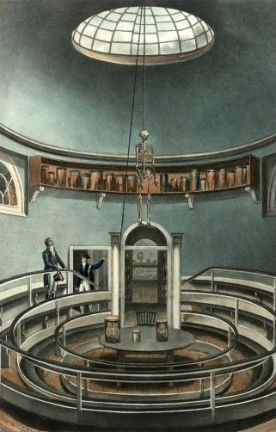The early days

Anatomy has most likely been taught within the University since its foundation in about 1231, for medicine was one of the earliest subjects to be studied. Initially, the teaching was of a theoretical nature based on readings of the classical texts of Galen in colleges, but the subject became established as an academic discipline in the early 16th century. In 1532 David Edwardes published from Cambridge the first anatomical text to be printed in England, and in 1549 anatomy became a statutory requirement for students of medicine. Shortly after, in 1557 John Caius introduced practical demonstrations of anatomy with dissection of the human body in his college, Gonville Hall, later to become Gonville and Caius College.
Teaching of anatomy, including demonstrations of dissection, continued to be college based during the second half of the 16th century and through the 17th century. A major shift towards more central involvement of the University was marked at the start of the 18th century when in 1707 the first Professor of Anatomy, George Rolfe, was appointed. This was followed in 1716 by the opening of the first Anatomical School, located in Queen’s Lane. With the gradual expansion of medical student numbers larger facilities were required, the School occupying three different sites in the City before the present building was opened on the Downing Site in 1938.
Further significant developments took place during the 19th century. William Clark (1817-1865), a distinguished comparative anatomist, advanced his discipline to the extent that on his retirement the Chair of Zoology was created. Responsibility for comparative anatomy was combined with that Chair, a separation that accounts for the fact that veterinary anatomy was initially taught in Zoology. Only in 1957 did Veterinary Anatomy move to its own building on the Downing Site alongside Human Anatomy, and was established as a Sub-Department.
Clark’s successor, Sir George Humphry FRS (1866-1883), was thus the first Professor of Human Anatomy. He was a founder of the Journal of Anatomy and Physiology, and the inaugural President of the Anatomical Society of Great Britain and Ireland. During the early tenure of his office anatomy and physiology were still taught together, but in 1870 Michael Foster was appointed as Praelector in Physiology. The course of the two disciplines became further separated on Humphry’s retirement with the establishment of the Chair of Physiology.
The current days
The twentieth century saw the Department flourish as a centre of excellence for both teaching and research, and the foundations were laid for the current strengths in developmental biology and neuroscience. Dixon Boyd (1951-1968) was renowned for his meticulous research on human fetal and placental development, and built up one of the world’s most cosmprehensive collections of embryological material that continues to be an important international resource today. More recently, Hans Kuypers FRS (1984-1989) fostered the Department’s strength in neuroanatomy and functional neuroscience, and in his own research pioneered innovative techniques for tracing complex neural networks.
During Hans Kuypers’s tenure the post of Clinical Anatomist was established to provide a focus for the teaching of clinically relevant topographical human anatomy at the undergraduate and postgraduate levels. Professor Harold Ellis was the first incumbent in 1988. The success of the venture led to the establishment of the equivalent Clinical Veterinary Anatomist position when, in 1993, the Sub-Department of Veterinary Anatomy was incorporated into the main Department. The teaching of both human and veterinary anatomy remains firmly rooted in cadaveric dissection, but sessions centred on common clinical procedures, live anatomy, and modern imaging techniques, such as ultrasound and endoscopy, ensure that it maintains a contemporary theme.
Anatomy remains at the core of preclinical medical and veterinary education, just as it did in the earliest days of the University, and the Department is committed to providing teaching of the highest quality to meet the needs of future practioners. At the research level the subject has undergone major transformations with the advent of sophisticated imaging techniques operating at the whole-body, through live cells down to the ultrastructural level, the introduction of model systems such as zebrafish and drosophila, the ability to identify and trace specific cell types with unique markers, and other major advances. In the post-genomic era anatomy is enjoying a resurgence as investigators seek to localise gene changes to specific sites, to understand cell-cell interactions during morphogenesis, or to trace and analyse complex neural networks. The study of gene through to function is a powerful research paradigm, and one which the bringing together again of Anatomy and Physiology will foster and enhance.
Early historical details based on The History of Anatomy in Cambridge by Dr CWM Pratt.

